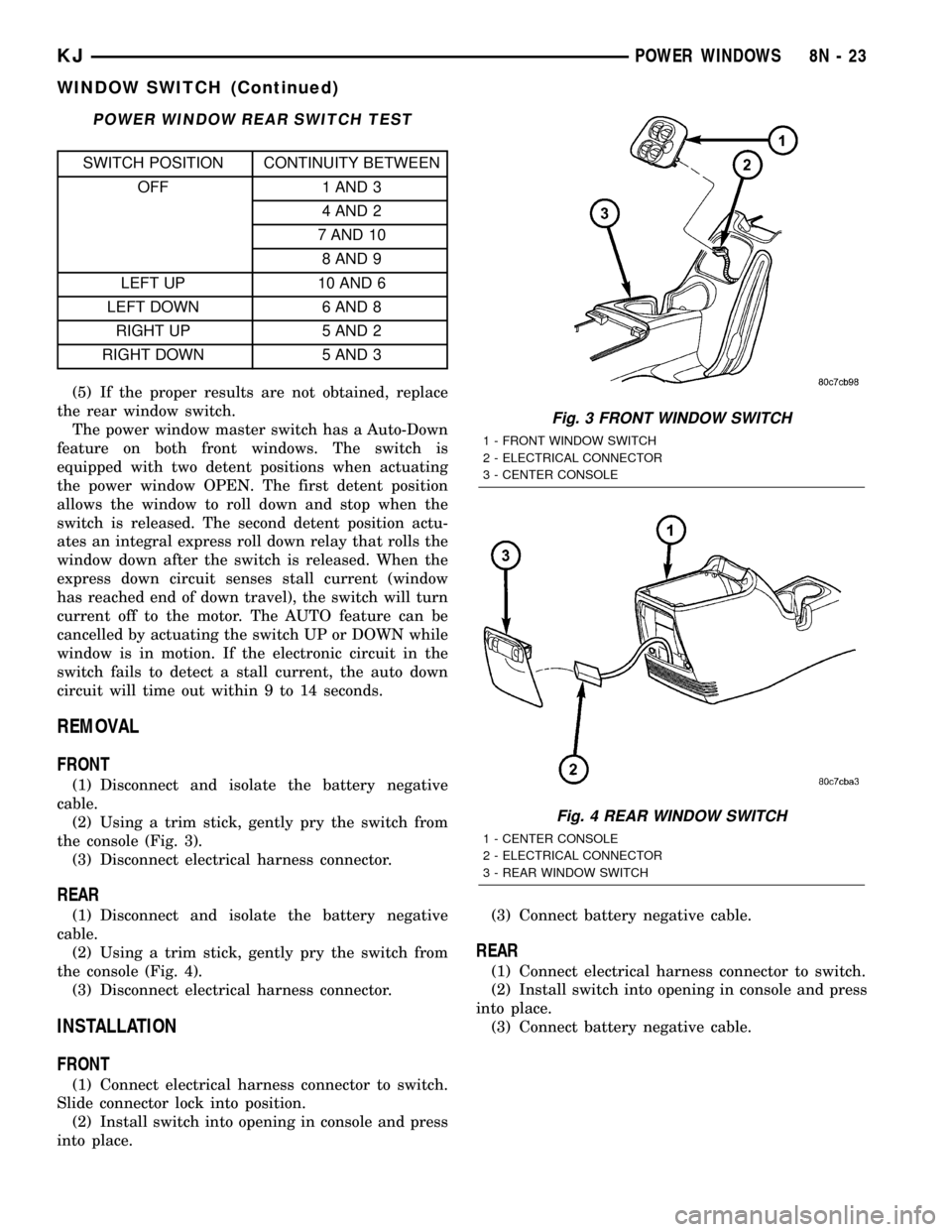relay JEEP LIBERTY 2002 KJ / 1.G Workshop Manual
[x] Cancel search | Manufacturer: JEEP, Model Year: 2002, Model line: LIBERTY, Model: JEEP LIBERTY 2002 KJ / 1.GPages: 1803, PDF Size: 62.3 MB
Page 610 of 1803

INSTALLATION
(1) Position the horn relay in the proper receptacle
in the Junction Block (JB).
(2) Push down firmly on the relay until the termi-
nals are fully seated.
(3) Connect the battery negative cable.
REMOTE KEYLESS ENTRY
MODULE
DESCRIPTION
When an RKE lock message is sent to the Body
Control Module (BCM), the BCM actuates the doors
and the tailgate lock, the interior lighting is turned
off, the horn chirps (if this feature is enabled), the
exterior lamps flash (if this feature is enabled) and, if
the vehicle is so equipped, the Vehicle Theft Security
System (VTSS) is armed. When an RKE unlock mes-
sage is sent to the BCM, the BCM actuates the
driver side front door (or all doors and the tailgate if
this feature is enabled) unlock, the interior lighting
is turned on and, if the vehicle is so equipped, the
VTSS is disarmed.When an RKE panic message is sent to the BCM,
the BCM actuates the driver side front door (or all
doors and the tailgate if this feature is enabled)
unlock, the interior lighting is turned on and, if the
vehicle is so equipped, the VTSS is disarmed. The
panic message will also cause the exterior lamps
(including the headlights) to flash, and the horn to
pulse for about three minutes, or until a second panic
message is sent to the BCM. A vehicle speed of about
25.7 kilometers-per-hour (15 miles-per-hour) will also
cancel the panic event.
Refer to the owner's manual for more information
on the features, use and operation of the RKE sys-
tem.
OPERATION
Whenever the vehicle battery power is interrupted,
the Remote Keyless Module (RKE) Module will retain
all vehicle access codes in its memory. When replac-
ing or adding a key fob transmitter (maximum of 4) a
DRB IIItscan tool is required to program the RKE
Module to accept the new Vehicle Access Code if a
customer owned transmitter is not available.
If a functioning transmitter is available, (Refer to 8
- ELECTRICAL/POWER LOCKS/KEYLESS ENTRY
TRANSMITTER - STANDARD PROCEDURE)
DIAGNOSIS AND TESTING - REMOTE KEYLESS
ENTRY MODULE
Refer to the appropriate wiring information. The
wiring information includes wiring diagrams, proper
wire and connector repair procedures, further details
on wire harness routing and retention, as well as
pin-out and location views for the various wire har-
ness connectors, splices and grounds. Refer to the
proper Body Diagnostic Procedures Manual for test-
ing the Remote Keyless Entry system using a DRB
IIItscan tool.
REMOVAL
(1) Disconnect and isolate the battery negative
cable.
(2) Remove the Junction Block (JB) (Refer to 8 -
ELECTRICAL/POWER DISTRIBUTION/JUNCTION
BLOCK - REMOVAL).
(3) Remove Remote Keyless Entry module from
Body Control Module (Fig. 5).
INSTALLATION
(1) Install Remote Keyless Entry module to Body
Control Module.
(2) Install Junction Block (JB) (Refer to 8 - ELEC-
TRICAL/POWER DISTRIBUTION/JUNCTION
BLOCK - INSTALLATION).
(3) Connect the battery negative cable.
Fig. 4 Power Lock Relay
30 - COMMON FEED
85 - COIL GROUND
86 - COIL BATTERY
87 - NORMALLY OPEN
87A - NORMALLY CLOSED
KJPOWER LOCKS 8N - 7
DOOR LOCK RELAY (Continued)
Page 626 of 1803

POWER WINDOW REAR SWITCH TEST
SWITCH POSITION CONTINUITY BETWEEN
OFF 1 AND 3
4 AND 2
7 AND 10
8 AND 9
LEFT UP 10 AND 6
LEFT DOWN 6 AND 8
RIGHT UP 5 AND 2
RIGHT DOWN 5 AND 3
(5) If the proper results are not obtained, replace
the rear window switch.
The power window master switch has a Auto-Down
feature on both front windows. The switch is
equipped with two detent positions when actuating
the power window OPEN. The first detent position
allows the window to roll down and stop when the
switch is released. The second detent position actu-
ates an integral express roll down relay that rolls the
window down after the switch is released. When the
express down circuit senses stall current (window
has reached end of down travel), the switch will turn
current off to the motor. The AUTO feature can be
cancelled by actuating the switch UP or DOWN while
window is in motion. If the electronic circuit in the
switch fails to detect a stall current, the auto down
circuit will time out within 9 to 14 seconds.
REMOVAL
FRONT
(1) Disconnect and isolate the battery negative
cable.
(2) Using a trim stick, gently pry the switch from
the console (Fig. 3).
(3) Disconnect electrical harness connector.
REAR
(1) Disconnect and isolate the battery negative
cable.
(2) Using a trim stick, gently pry the switch from
the console (Fig. 4).
(3) Disconnect electrical harness connector.
INSTALLATION
FRONT
(1) Connect electrical harness connector to switch.
Slide connector lock into position.
(2) Install switch into opening in console and press
into place.(3) Connect battery negative cable.
REAR
(1) Connect electrical harness connector to switch.
(2) Install switch into opening in console and press
into place.
(3) Connect battery negative cable.
Fig. 3 FRONT WINDOW SWITCH
1 - FRONT WINDOW SWITCH
2 - ELECTRICAL CONNECTOR
3 - CENTER CONSOLE
Fig. 4 REAR WINDOW SWITCH
1 - CENTER CONSOLE
2 - ELECTRICAL CONNECTOR
3 - REAR WINDOW SWITCH
KJPOWER WINDOWS 8N - 23
WINDOW SWITCH (Continued)
Page 684 of 1803

²Combination Flasher- An electronic combina-
tion flasher is integral to the hazard switch located
in the center of the instrument panel above the
radio. (Refer to 8 - ELECTRICAL/LAMPS/LIGHT-
ING - EXTERIOR/COMBINATION FLASHER -
DESCRIPTION).
²Door Ajar Switch- A door ajar switch is inte-
gral to the latch of each door in the vehicle. (Refer to
8 - ELECTRICAL/LAMPS/LIGHTING - INTERIOR/
DOOR AJAR SWITCH - DESCRIPTION).
²Door Cylinder Lock Switch- For North
American vehicles only, a door cylinder lock switch is
located on the back of the lock cylinder of each front
door. (Refer to 8 - ELECTRICAL/VEHICLE THEFT
SECURITY/DOOR CYLINDER LOCK SWITCH -
DESCRIPTION).
²Flip-Up Glass Ajar Switch- A flip-up glass
ajar switch is integral to the rear flip-up glass latch,
located on the top of the tailgate near the center.
(Refer to 8 - ELECTRICAL/LAMPS/LIGHTING -
INTERIOR/FLIP-UP GLASS AJAR SWITCH -
DESCRIPTION).
²Hood Ajar Switch- A hood ajar switch is
located beneath the hood panel on the right inner
fender side shield of vehicles built for sale in certain
markets where it is required equipment. (Refer to 8 -
ELECTRICAL/VEHICLE THEFT SECURITY/HOOD
AJAR SWITCH - DESCRIPTION).
²Horn Relay- A horn relay is located on the
Junction Block (JB) under the driver side outboard
end of the instrument panel. (Refer to 8 - ELECTRI-
CAL/HORN/HORN RELAY - DESCRIPTION).
²Intrusion Transceiver Module- An Intrusion
Transceiver Module (ITM) is located near the center
of the headliner in the passenger compartment of
vehicles built for sale in certain markets where it is
required equipment. (Refer to 8 - ELECTRICAL/VE-
HICLE THEFT SECURITY/UK SECURITY SYSTEM
MODULE - DESCRIPTION).
²Security Indicator- A security indicator is
located in the ElectroMechanical Instrument Cluster
(EMIC) on the instrument panel in front of the driver
side front seat. (Refer to 8 - ELECTRICAL/INSTRU-
MENT CLUSTER/SECURITY INDICATOR -
DESCRIPTION).
²Siren- An alarm siren is located on the front
extension of the right front wheel house panel in the
engine compartment of vehicles built for sale in cer-
tain markets where it is required equipment. (Refer
to 8 - ELECTRICAL/VEHICLE THEFT SECURITY/
SIREN - DESCRIPTION).
²Tailgate Ajar Switch- A tailgate ajar switch is
integral to the latch for the tailgate in the vehicle.
(Refer to 8 - ELECTRICAL/LAMPS/LIGHTING -
INTERIOR/TAILGATE AJAR SWITCH - DESCRIP-
TION).SENTRY KEY IMMOBILIZER SYSTEM The Sen-
try Key Immobilizer System (SKIS) is available as a
factory-installed option on this model. Vehicles
equipped with the Vehicle Theft Alarm (VTA) are also
equipped with SKIS. The SKIS provides passive vehi-
cle protection by preventing the engine from operat-
ing unless a valid electronically encoded key is
detected in the ignition lock cylinder. The SKIS
includes the following major components, which are
described in further detail elsewhere in this service
information:
²Powertrain Control Module- The Powertrain
Control Module (PCM) is located on the left inner
fender shield in the engine compartment near the
dash panel. (Refer to 8 - ELECTRICAL/ELEC-
TRONIC CONTROL MODULES/POWERTRAIN
CONTROL MODULE - DESCRIPTION).
²Sentry Key Immobilizer Module- The Sentry
Key Immobilizer Module (SKIM) is located beneath
the steering column shrouds on the right side of the
steering column near the ignition lock cylinder hous-
ing. (Refer to 8 - ELECTRICAL/ELECTRONIC CON-
TROL MODULES/SENTRY KEY IMMOBILIZER
MODULE - DESCRIPTION).
²Sentry Key Transponder- The Sentry Key
transponder is molded into the head of the ignition
key, and concealed by a gray molded rubber cap.
(Refer to 8 - ELECTRICAL/VEHICLE THEFT SECU-
RITY/TRANSPONDER KEY - DESCRIPTION).
²SKIS Indicator- The SKIS indicator is located
in the ElectroMechanical Instrument Cluster (EMIC)
on the instrument panel in front of the driver side
front seat. (Refer to 8 - ELECTRICAL/INSTRU-
MENT CLUSTER/SPEED CONTROL INDICATOR -
DESCRIPTION).
OPERATION
The Vehicle Theft Security System (VTSS) is
divided into two basic subsystems: Vehicle Theft
Alarm (VTA) and Sentry Key Immobilizer System
(SKIS). Following are paragraphs that briefly
describe the operation of each of these two sub-
systems.
VEHICLE THEFT ALARM The Body Control Mod-
ule (BCM) is used on this model to control and inte-
grate many of the electronic functions and features
included in the Vehicle Theft Alarm (VTA). The BCM
receives hard wired inputs indicating the status of
the door ajar switches, the door cylinder lock
switches, the ignition switch, the tailgate ajar switch,
the tailgate cylinder lock switch, the flip-up glass
ajar switch, the power lock switches and, in vehicles
built for certain markets where it is required, the
hood ajar switch. The programming in the BCM
allows it to process the information from all of these
inputs and send control outputs to energize or de-en-
KJVEHICLE THEFT SECURITY 8Q - 3
VEHICLE THEFT SECURITY (Continued)
Page 685 of 1803

ergize the combination flasher, the horn relay (except
vehicles with the Rest-Of-World or ROW premium
version of the VTA), and the security indicator. In
addition, in vehicles built for certain markets where
the ROW premium version of the VTA is required,
the BCM also exchanges electronic messages with
the Intrusion Transceiver Module (ITM) over the Pro-
grammable Communications Interface (PCI) data bus
network to provide the features found in this version
of the VTA.
The hard wired circuits and components of the
VTA may be diagnosed and tested using conventional
diagnostic tools and procedures. However, conven-
tional diagnostic methods may not prove conclusive
in the diagnosis of the Body Control Module (BCM),
the ElectroMechanical Instrument Cluster (EMIC),
the Intrusion Transceiver Module (ITM), or the Pro-
grammable Communications Interface (PCI) data bus
network. The most reliable, efficient, and accurate
means to diagnose the BCM, the EMIC, the ITM,
and the PCI data bus network inputs and outputs
related to the VTA requires the use of a DRBIIIt
scan tool. Refer to the appropriate diagnostic infor-
mation. Following are paragraphs that briefly
describe the operation of each of the VTA features.
See the owner's manual in the vehicle glove box for
more information on the features, use and operation
of the VTA.
²ENABLING- The BCM must have the VTA
function electronically enabled in order for the VTA
to perform as designed. The logic in the BCM keeps
its VTA function dormant until it is enabled using a
DRBIIItscan tool. The VTA function of the BCM is
enabled on vehicles equipped with the VTA option at
the factory, but a service replacement BCM must be
VTA-enabled by the dealer using a DRBIIItscan
tool. Refer to the appropriate diagnostic information.
²PRE-ARMING- The VTA has a pre-arming
sequence. Pre-arming occurs when a door, the tail-
gate, or the flip-up glass is open when the vehicle is
locked using a power lock switch, or when the ªLockº
button on the Remote Keyless Entry (RKE) transmit-
ter is depressed. The power lock switch will not ini-
tiate the pre-arming sequence if the key is in the
ignition switch. When the VTA is pre-armed, the
arming sequence is delayed until all of the doors, the
tailgate, and the flip-up glass are closed.
²ARMING- Passive arming of the VTA occurs
when the vehicle is exited with the key removed from
the ignition switch and the doors are locked while
they are open using the power lock switch (see Pre-
Arming). Active arming of the VTA occurs when the
ªLockº button on the Remote Keyless Entry (RKE)
transmitter is depressed to lock the vehicle after all
of the doors, the tailgate, and the flip-up glass are
closed. The VTA will not arm if the doors are lockedusing the key in a lock cylinder or using a mechani-
cal lock button. Once the VTA begins the passive or
active arming sequence, the security indicator in the
instrument cluster will flash rapidly for about six-
teen seconds. This indicates that the VTA arming
sequence is in progress. If the ignition switch is
turned to the On position, if a door is unlocked with
the power lock switch or the RKE transmitter, or if
the tailgate is unlocked by any means during the six-
teen second arming sequence, the security indicator
will stop flashing and the VTA arming sequence will
abort. On vehicles equipped with the hood ajar
switch, the VTA arming sequence will occur regard-
less of whether the hood is open or closed, but the
underhood area will not be protected unless the hood
is closed when the VTA arming sequence begins.
Also, if the status of the hood ajar switch changes
from open (hood closed) to closed (hood open) during
the sixteen second arming sequence, the security
indicator will stop flashing and the VTA arming
sequence will abort. Once the sixteen second arming
sequence is successfully completed, the security indi-
cator will flash at a slower rate, indicating that the
VTA is armed.
²DISARMING- For vehicles built for the North
American market, disarming of the VTA occurs when
the vehicle is unlocked using the key to unlock a door
or the tailgate. Disarming of the VTA for any market
also occurs when the vehicle is unlocked by depress-
ing the ªUnlockº button of the Remote Keyless Entry
(RKE) transmitter, or by turning the ignition switch
to the On position using a valid Sentry Key Immobi-
lizer System (SKIS) key. Once the alarm has been
activated, any of these disarming methods will also
deactivate the alarm.
²POWER-UP MODE- When the armed VTA
senses that the battery has been disconnected and
reconnected, it enters its power-up mode. In the pow-
er-up mode the alarm system returns to the mode
that was last selected prior to the battery failure or
disconnect. If the VTA was armed prior to the battery
disconnect or failure, the technician or vehicle opera-
tor will have to actively or passively disarm the sys-
tem after the battery is reconnected. The power-up
mode will also apply if the battery goes dead while
the system is armed, and battery jump-starting is
then attempted. The VTA will remain armed until
the technician or vehicle operator has actively or pas-
sively disarmed the system. If the VTA is in the dis-
armed mode prior to a battery disconnect or failure,
it will remain disarmed after the battery is recon-
nected or replaced, or if jump-starting is attempted.
²ALARM- The VTA alarm output varies by the
version of the VTA with which the vehicle is
equipped. In all cases, the alarm provides both visual
and audible outputs; however, the time intervals of
8Q - 4 VEHICLE THEFT SECURITYKJ
VEHICLE THEFT SECURITY (Continued)
Page 702 of 1803

WIPERS/WASHERS
TABLE OF CONTENTS
page page
FRONT WIPERS/WASHERS.................. 1REAR WIPERS/WASHERS.................. 27
FRONT WIPERS/WASHERS
TABLE OF CONTENTS
page page
FRONT WIPERS/WASHERS
DESCRIPTION..........................2
OPERATION............................4
DIAGNOSIS AND TESTING - FRONT WIPER &
WASHER SYSTEM.....................6
CLEANING - FRONT WIPER & WASHER
SYSTEM.............................7
INSPECTION - FRONT WIPER & WASHER
SYSTEM.............................7
FRONT CHECK VALVE
DESCRIPTION..........................8
OPERATION............................9
REMOVAL.............................9
INSTALLATION..........................9
FRONT WASHER HOSES/TUBES
DESCRIPTION.........................10
OPERATION...........................10
FRONT WASHER NOZZLE
DESCRIPTION.........................11
OPERATION...........................11
REMOVAL.............................11
INSTALLATION.........................11
FRONT WIPER ARM
DESCRIPTION.........................12
OPERATION...........................12
REMOVAL.............................12
INSTALLATION.........................13
FRONT WIPER BLADE
DESCRIPTION.........................13
OPERATION...........................14
REMOVAL.............................14
INSTALLATION.........................14
FRONT WIPER MODULE
DESCRIPTION.........................15
OPERATION...........................15REMOVAL.............................16
INSTALLATION.........................16
FRONT WIPER/WASHER SWITCH
DESCRIPTION.........................16
OPERATION...........................16
WASHER FLUID LEVEL SWITCH
DESCRIPTION.........................17
OPERATION...........................17
REMOVAL.............................17
INSTALLATION.........................18
WASHER PUMP/MOTOR
DESCRIPTION.........................18
OPERATION...........................19
REMOVAL.............................19
INSTALLATION.........................20
WASHER RESERVOIR
DESCRIPTION.........................21
OPERATION...........................21
REMOVAL.............................21
INSTALLATION.........................22
WIPER HIGH/LOW RELAY
DESCRIPTION.........................23
OPERATION...........................23
DIAGNOSIS AND TESTING - WIPER HIGH/
LOW RELAY.........................24
REMOVAL.............................24
INSTALLATION.........................24
WIPER ON/OFF RELAY
DESCRIPTION.........................25
OPERATION...........................25
DIAGNOSIS AND TESTING - WIPER ON/OFF
RELAY..............................26
REMOVAL.............................26
INSTALLATION.........................26
KJWIPERS/WASHERS 8R - 1
Page 704 of 1803

An electrically operated intermittent front wiper
and washer system is standard factory-installed
safety equipment on this model (Fig. 1). The front
wiper and washer system includes the following
major components, which are described in further
detail elsewhere in this service information:
²Body Control Module- The Body Control
Module (BCM) is located on the Junction Block (JB)
under the driver side outboard end of the instrument
panel. (Refer to 8 - ELECTRICAL/ELECTRONIC
CONTROL MODULES/BODY CONTROL MODULE
- DESCRIPTION).
²Front Check Valve- The front washer system
check valve is integral to the wye fitting located in
the washer plumbing between the cowl plenum
washer hose and the front washer nozzles, and is
concealed beneath the cowl plenum cover/grille panel
at the base of the windshield.
²Front Washer Nozzle- Two fluidic front
washer nozzles are secured with integral snap fea-
tures to dedicated openings in the cowl plenum cover/
grille panel located near the base of the windshield.
²Front Washer Plumbing- The plumbing for
the front washer system consists of rubber hoses and
molded plastic fittings. The plumbing is routed along
the right side of the engine compartment from the
washer reservoir, and through the dash panel into
the cowl plenum to the front washer nozzle fittings
beneath the cowl plenum cover/grille panel.
²Front Wiper Arm- The two front wiper arms
are secured with nuts to the threaded studs on the
ends of the two wiper pivot shafts, which extend
through the cowl plenum cover/grille panel located
near the base of the windshield.
²Front Wiper Blade- The two front wiper
blades are secured to the two front wiper arms with
an integral latch, and are parked on the glass near
the bottom of the windshield when the front wiper
system is not in operation.
²Front Wiper Module- The front wiper pivot
shafts are the only visible components of the front
wiper module. The remainder of the module is con-
cealed within the cowl plenum area beneath the cowl
plenum cover/grille panel. The front wiper module
includes the wiper module bracket, four rubber-iso-
lated wiper module mounts, the front wiper motor,
the wiper motor crank arm, the two wiper drive
links, and the two front wiper pivots.
²Multi-Function Switch- The multi-function
switch is located on the top of the steering column,
just below the steering wheel. The multi-function
switch includes a left (lighting) control stalk and a
right (wiper) control stalk. The right control stalk is
dedicated to providing all of the driver controls for
both the front and rear wiper systems. (Refer to 8 -ELECTRICAL/LAMPS/LIGHTING - EXTERIOR/
MULTI-FUNCTION SWITCH - DESCRIPTION).
²Washer Fluid Level Switch- The washer fluid
level switch is located in a dedicated hole near the
center of the rearward facing surface of the washer
reservoir, behind the right front wheel house splash
shield.
²Washer Pump/Motor- The reversible electric
washer pump/motor unit is located in a dedicated
hole on the lower outboard side of the washer reser-
voir, behind the right front wheel house splash
shield. This single reversible washer pump/motor
provides washer fluid to either the front or rear
washer system plumbing, depending upon the direc-
tion of the pump motor rotation.
²Washer Reservoir- The washer reservoir is
concealed behind the right front wheel house splash
shield ahead of the right front wheel. The washer
reservoir filler neck is the only visible portion of the
reservoir, and it is accessed from the right front cor-
ner of the engine compartment.
²Wiper High-Low Relay- The wiper high-low
relay is an International Standards Organization
(ISO) micro relay located in the Power Distribution
Center (PDC) in the engine compartment near the
battery.
²Wiper On-Off Relay- The wiper on-off relay is
an International Standards Organization (ISO) micro
relay located in the Power Distribution Center (PDC)
in the engine compartment near the battery.
Hard wired circuitry connects the front wiper and
washer system components to the electrical system of
the vehicle. These hard wired circuits are integral to
several wire harnesses, which are routed throughout
the vehicle and retained by many different methods.
These circuits may be connected to each other, to the
vehicle electrical system and to the front wiper and
washer system components through the use of a com-
bination of soldered splices, splice block connectors,
and many different types of wire harness terminal
connectors and insulators. Refer to the appropriate
wiring information. The wiring information includes
wiring diagrams, proper wire and connector repair
procedures, further details on wire harness routing
and retention, as well as pin-out and location views
for the various wire harness connectors, splices and
grounds.
OPERATING MODES The components of the front
wiper and washer system are designed to work in
concert to provide the following operating modes:
²Continuous Wipe Mode- The control knob on
the right (wiper) control stalk of the multi-function
switch has two continuous wipe positions, Low and
High. When selected, these switch positions will
cause the two-speed front wiper motor to operate in a
continuous low or high speed cycle.
KJFRONT WIPERS/WASHERS 8R - 3
FRONT WIPERS/WASHERS (Continued)
Page 705 of 1803

²Intermittent Wipe Mode- The control knob on
the right (wiper) control stalk of the multi-function
switch has five minor detent intermittent wipe posi-
tions. When selected, these switch positions will
cause the front wiper system to operate with one of
five delay intervals between complete wipe cycles.
²Mist Wipe Mode- The right (wiper) control
stalk of the multi-function switch has a momentary
Mist position. When selected, this switch position
will operate the front wipers in a low speed continu-
ous cycle for as long as the switch is held closed,
then will complete the current wipe cycle and park
the front wiper blades near the base of the wind-
shield when the switch is released.
²Washer Mode- When the momentary front
wash position of the right (wiper) control stalk of the
multi-function switch is selected with the front wiper
system operating in a continuous wipe mode, washer
fluid will be dispensed onto the windshield glass
through the washer nozzles for as long as the washer
switch is held closed. When the front washer switch
is actuated with the front wiper system operating in
an intermittent wipe mode, washer fluid is still dis-
pensed until the switch is released; however, the
front wipers will operate in a low speed continuous
cycle from the time the washer switch is closed until
several wipe cycles after the switch is released,
before returning to the selected intermittent wipe
mode.
²Wipe-After-Wash Mode- When the momentary
front wash position of the right (wiper) control stalk
of the multi-function switch is selected with the front
wiper system turned Off, the internal circuitry of the
BCM provides a wipe-after-wash feature. When
selected, this feature will operate the washer pump/
motor and the front wipers for as long as the front
washer switch is held closed, then provide several
additional wipe cycles after the switch is released
before parking the front wiper blades near the base
of the windshield.
OPERATION
The front wiper and washer system is designed to
provide the vehicle operator with a convenient, safe,
and reliable means of maintaining visibility through
the windshield glass. The various components of this
system are designed to convert electrical energy pro-
duced by the vehicle electrical system into the
mechanical action of the wiper blades to wipe the
outside surface of the glass, as well as into the
hydraulic action of the washer system to apply
washer fluid stored in an on-board reservoir to the
area of the glass to be wiped. When combined, these
components provide the means to effectively main-
tain clear visibility for the vehicle operator by remov-
ing excess accumulations of rain, snow, bugs, mud, orother minor debris from the outside windshield glass
surface that might be encountered while driving the
vehicle under numerous types of inclement operating
conditions.
The vehicle operator initiates all front wiper and
washer system functions with the right (wiper) con-
trol stalk of the multi-function switch that extends
from the right side of the steering column, just below
the steering wheel. Rotating the control knob on the
end of the control stalk, selects the Off, Delay, Low,
or High front wiper system operating modes. In the
Delay mode, the control knob also allows the vehicle
operator to select from one of five intermittent wipe
Delay intervals. Pulling the right control stalk down-
wards actuates the momentary front wiper system
Mist mode switch, while pulling the right control
stalk towards the steering wheel actuates the
momentary front washer system switch. The multi-
function switch provides hard wired resistor multi-
plexed inputs to the Body Control Module (BCM) for
all of the front wiper system functions, as well as a
separate hard wired sense input to the BCM for the
front washer system function.
The front wiper and washer system will only oper-
ate when the ignition switch is in the Accessory or
On positions. Battery current is directed from a B(+)
fuse in the Power Distribution Center (PDC) to the
wiper and washer system circuit breaker in the Junc-
tion Block (JB) through a fused ignition switch out-
put (run-acc) circuit. The automatic resetting circuit
breaker then provides battery current through a
fused ignition switch output (run-acc) circuit to the
wiper high/low relay, the wiper on/off relay, and the
park switch within the front wiper motor. A separate
fuse in the JB provides battery current through
another fused ignition switch output (run-acc) circuit
to the multi-function switch. The multi-function
switch circuitry uses this battery feed and a ground
circuit input to directly control the operation and
direction of the reversible electric washer pump/mo-
tor unit. The BCM uses low side drivers to control
front wiper system operation by energizing or de-en-
ergizing the wiper high/low and wiper on/off relays.
The hard wired circuits and components of the
front wiper and washer system may be diagnosed
and tested using conventional diagnostic tools and
procedures. However, conventional diagnostic meth-
ods may not prove conclusive in the diagnosis of the
Body Control Module (BCM), or the inputs to or out-
puts from the BCM that control the front wiper and
washer system operating modes. The most reliable,
efficient, and accurate means to diagnose the BCM,
or the BCM inputs and outputs related to the various
front wiper and washer system operating modes
requires the use of a DRBIIItscan tool. Refer to the
appropriate diagnostic information.
8R - 4 FRONT WIPERS/WASHERSKJ
FRONT WIPERS/WASHERS (Continued)
Page 706 of 1803

Following are paragraphs that briefly describe the
operation of each of the front wiper and washer sys-
tem operating modes.
CONTINUOUS WIPE MODE When the Low posi-
tion of the control knob on the right (wiper) control
stalk of the multi-function switch is selected, the
Body Control Module (BCM) energizes the wiper
on/off relay. This directs battery current through the
normally open contacts of the energized wiper on/off
relay and the normally closed contacts of the de-en-
ergized wiper high/low relay to the low speed brush
of the front wiper motor, causing the front wipers to
cycle at low speed. When the High position of the
control knob is selected, the BCM energizes both the
wiper on/off relay and the wiper high/low relay. This
directs battery current through the normally open
contacts of the energized wiper on/off relay and the
normally open contacts of the energized wiper high/
low relay to the high speed brush of the front wiper
motor, causing the front wipers to cycle at high
speed.
When the Off position of the control knob is
selected, the BCM de-energizes both the wiper on/off
and wiper high low relays, then one of two events
will occur. The event that occurs depends upon the
position of the wiper blades on the windshield at the
moment that the control knob Off position is selected.
If the wiper blades are in the down position on the
windshield when the Off position is selected, the
park switch that is integral to the front wiper motor
is closed to ground and the wiper motor ceases to
operate. If the wiper blades are not in the down posi-
tion on the windshield at the moment the Off posi-
tion is selected, the park switch is closed to battery
current from the fused ignition switch output (run-
acc) circuit of the front wiper motor. The park switch
directs this battery current to the low speed brush of
the wiper motor through the wiper park switch sense
circuit and the normally closed contacts of the de-en-
ergized wiper on/off and wiper high/low relays. This
causes the wiper motor to continue running at low
speed until the wiper blades are in the down position
on the windshield and the park switch is again
closed to ground.
INTERMITTENT WIPE MODE When the control
knob on the right (wiper) control stalk of the multi-
function switch is moved to one of the Delay interval
positions, the BCM electronic intermittent wipe logic
circuit responds by calculating the correct length of
time between wiper sweeps based upon the selected
delay interval input. The BCM monitors the chang-
ing state of the wiper motor park switch through a
hard wired front wiper park switch sense circuit
input. This input allows the BCM to determine the
proper intervals at which to energize and de-energize
the wiper on/off relay to operate the front wipermotor intermittently for one low speed cycle at a
time. The BCM logic is also programmed to provide
an immediate wipe cycle and begin a new delay
interval timing cycle each time a shorter delay inter-
val is selected, and to add the remaining delay tim-
ing interval to the new delay interval timing before
the next wipe cycle occurs each time a longer delay
interval is selected.
MIST WIPE MODE When the right (wiper) control
stalk of the multi-function switch is moved to the
momentary Mist position, the BCM energizes the
wiper on/off relay for as long as the Mist switch is
held closed, then de-energizes the relay when the
state of the Mist switch input changes to open. The
BCM can operate the front wiper motor in this mode
for only one low speed cycle at a time, or for an
indefinite number of sequential low speed cycles,
depending upon how long the Mist switch is held
closed.
WASH MODE When the right (wiper) control stalk
of the multi-function switch is moved to the momen-
tary front Wash position while the control knob is in
the Low or High positions, the circuitry within the
switch directs battery current and ground to the
washer pump/motor unit. This will cause the washer
pump/motor unit to be energized for as long as the
front Wash switch is held closed, and to de-energize
when the front Wash switch is released. When the
right (wiper) control stalk of the multi-function
switch is moved to the momentary front Wash posi-
tion while the control knob is in one of the Delay
interval positions, the front washer pump/motor oper-
ation is the same. However, the BCM energizes the
wiper on/off relay to override the selected delay inter-
val and operate the front wiper motor in a continu-
ous low speed mode for as long as the front Wash
switch is held closed, then de-energizes the relay and
reverts to the selected delay mode interval several
wipe cycles after the front Wash switch is released.
The BCM detects the front Wash switch state
through a hard wired washer pump driver circuit
input from the multi-function switch.
WIPE-AFTER-WASH MODE When the right
(wiper) control stalk of the multi-function switch is
moved to the momentary front Wash position while
the control knob is in the Off position, the BCM
detects that switch state through a hard wired
washer pump driver circuit input from the multi-
function switch. The BCM responds to this input by
energizing the wiper on/off relay for as long as the
Wash switch is held closed, then de-energizes the
relay several wipe cycles after the front Wash switch
is released. The BCM monitors the changing state of
the wiper motor park switch through a hard wired
front wiper park switch sense circuit input. This
input allows the BCM to count the number of wipe
KJFRONT WIPERS/WASHERS 8R - 5
FRONT WIPERS/WASHERS (Continued)
Page 707 of 1803

cycles that occur after the front Wash switch state
changes to open, and to determine the proper inter-
val at which to de-energize the wiper on/off relay to
complete the wipe-after-wash mode cycle.
DIAGNOSIS AND TESTING - FRONT WIPER &
WASHER SYSTEM
FRONT WIPER SYSTEM
If the front wiper motor operates, but the wipers
do not move on the windshield, replace the faulty
front wiper module. If the wipers operate, but chat-
ter, lift, or do not clear the glass, clean and inspect
the front wiper system components as required.
(Refer to 8 - ELECTRICAL/FRONT WIPERS/WASH-
ERS - INSPECTION) and (Refer to 8 - ELECTRI-
CAL/FRONT WIPERS/WASHERS - CLEANING). For
diagnosis and testing of the multi-function switch
(Refer to 8 - ELECTRICAL/LAMPS/LIGHTING -
EXTERIOR/MULTI-FUNCTION SWITCH - DIAG-
NOSIS AND TESTING). Refer to the appropriate
wiring information. The wiring information includes
wiring diagrams, proper wire and connector repair
procedures, details of wire harness routing and
retention, connector pin-out information and location
views for the various wire harness connectors, splices
and grounds.
The hard wired circuits and components of the
front wiper and washer system may be diagnosed
and tested using conventional diagnostic tools and
procedures. However, conventional diagnostic meth-
ods may not prove conclusive in the diagnosis of the
Body Control Module (BCM), or the inputs to or out-
puts from the BCM that control the various front
wiper and washer system operating modes. The most
reliable, efficient, and accurate means to diagnose
the BCM, or the BCM inputs and outputs related to
the various front wiper and washer system operating
modes requires the use of a DRBIIItscan tool. Refer
to the appropriate diagnostic information.
WARNING: ON VEHICLES EQUIPPED WITH AIR-
BAGS, DISABLE THE SUPPLEMENTAL RESTRAINT
SYSTEM BEFORE ATTEMPTING ANY STEERING
WHEEL, STEERING COLUMN, DRIVER AIRBAG,
PASSENGER AIRBAG, SEAT BELT TENSIONER,
SIDE CURTAIN AIRBAG, OR INSTRUMENT PANEL
COMPONENT DIAGNOSIS OR SERVICE. DISCON-
NECT AND ISOLATE THE BATTERY NEGATIVE
(GROUND) CABLE, THEN WAIT TWO MINUTES FOR
THE SYSTEM CAPACITOR TO DISCHARGE BEFORE
PERFORMING FURTHER DIAGNOSIS OR SERVICE.
THIS IS THE ONLY SURE WAY TO DISABLE THE
SUPPLEMENTAL RESTRAINT SYSTEM. FAILURE TO
TAKE THE PROPER PRECAUTIONS COULDRESULT IN ACCIDENTAL AIRBAG DEPLOYMENT
AND POSSIBLE PERSONAL INJURY.
FRONT WASHER SYSTEM
The diagnosis found here addresses an electrically
inoperative front washer system. If the washer
pump/motor operates, but no washer fluid is emitted
from the front washer nozzles, be certain to check
the fluid level in the reservoir. Also inspect the front
washer system components as required. (Refer to 8 -
ELECTRICAL/FRONT WIPERS/WASHERS -
INSPECTION). Refer to the appropriate wiring infor-
mation. The wiring information includes wiring dia-
grams, proper wire and connector repair procedures,
details of wire harness routing and retention, connec-
tor pin-out information and location views for the
various wire harness connectors, splices and grounds.
WARNING: ON VEHICLES EQUIPPED WITH AIR-
BAGS, DISABLE THE SUPPLEMENTAL RESTRAINT
SYSTEM BEFORE ATTEMPTING ANY STEERING
WHEEL, STEERING COLUMN, DRIVER AIRBAG,
PASSENGER AIRBAG, SEAT BELT TENSIONER,
SIDE CURTAIN AIRBAG, OR INSTRUMENT PANEL
COMPONENT DIAGNOSIS OR SERVICE. DISCON-
NECT AND ISOLATE THE BATTERY NEGATIVE
(GROUND) CABLE, THEN WAIT TWO MINUTES FOR
THE SYSTEM CAPACITOR TO DISCHARGE BEFORE
PERFORMING FURTHER DIAGNOSIS OR SERVICE.
THIS IS THE ONLY SURE WAY TO DISABLE THE
SUPPLEMENTAL RESTRAINT SYSTEM. FAILURE TO
TAKE THE PROPER PRECAUTIONS COULD
RESULT IN ACCIDENTAL AIRBAG DEPLOYMENT
AND POSSIBLE PERSONAL INJURY.
(1) Turn the ignition switch to the On position.
Turn the control knob on the right (wiper) control
stalk of the multi-function switch to the On position.
Check whether the front wiper system is operating.
If OK, go to Step 2. If not OK, test and repair the
front wiper system before continuing with these
tests. Refer to FRONT WIPER SYSTEM .
(2) Turn the control ring on the right (wiper) con-
trol stalk of the multi-function switch to the rear
Wash position. Check whether the rear washer sys-
tem is operating. If OK, test the multi-function
switch. (Refer to 8 - ELECTRICAL/LAMPS/LIGHT-
ING - EXTERIOR/MULTI-FUNCTION SWITCH -
DIAGNOSIS AND TESTING). If the multi-function
switch tests OK, go to Step 3. If the multi-function
switch does not test OK, replace the faulty switch.
(3) Turn the ignition switch to the Off position.
Disconnect and isolate the battery negative cable.
Disconnect the headlamp and dash wire harness con-
nector for the washer pump/motor unit from the
pump/motor unit connector receptacle. Check for con-
tinuity between the washer pump driver circuit cav-
8R - 6 FRONT WIPERS/WASHERSKJ
FRONT WIPERS/WASHERS (Continued)
Page 716 of 1803

FRONT WIPER MODULE
DESCRIPTION
The front wiper module bracket is secured with
two nuts below the wiper motor through rubber insu-
lators to two weld studs on the bottom of the cowl
plenum panel beneath the cowl plenum cover/grille
panel (Fig. 14). Two screws secure the top of the
module bracket to the cowl plenum panel through
rubber insulators located on the outboard end of each
pivot bracket. The ends of the wiper pivot shafts that
protrude through dedicated openings in the cowl ple-
num cover/grille panel to drive the wiper arms and
blades are the only visible components of the front
wiper module. The front wiper module consists of the
following major components:
²Bracket- The front wiper module bracket con-
sists of a long tubular steel main member that has a
die cast pivot bracket formation near each end where
the two wiper pivots are secured. A stamped steel
mounting plate for the wiper motor is secured with
welds near the center of the main member. A short
stamped steel tab that extends laterally from one
side of the mounting plate provides a mounting loca-
tion for the wiper motor pigtail wire connector.
²Crank Arm- The front wiper motor crank arm
is a stamped steel unit with a slotted hole on thedriven end that is secured to the wiper motor output
shaft with a nut, and has a ball stud secured to the
drive end.
²Linkage- Two stamped steel drive links con-
nect the wiper motor crank arm to the wiper pivot
lever arms. The right side drive link has a plastic
socket-type bushing on each end. The left side drive
link has a plastic socket-type bushing on one end,
and a plastic sleeve-type bushing on the other end.
The socket-type bushing on one end of each drive
link is snap-fit over the ball stud on the lever arm of
its respective pivot. The left side drive link sleeve-
type bushing end is then fit over the motor crank
arm ball stud, and the other socket-type bushing of
the right side drive link is snap-fit over the exposed
end of the wiper motor crank arm ball stud.
²Motor- The front wiper motor is secured with
three screws to the motor mounting plate near the
center of the wiper module bracket. The wiper motor
output shaft passes through a hole in the module
bracket, where a nut secures the wiper motor crank
arm to the motor output shaft. The two-speed perma-
nent magnet wiper motor features an integral trans-
mission, an internal park switch, and an internal
automatic resetting circuit breaker. A molded plastic
shield covers the top of the motor.
²Pivots- The two front wiper pivots are secured
within the die cast pivot brackets on the outboard
ends of the wiper module main member. The lever
arms that extend from the center of the pivot shafts
each have a ball stud on their end. The upper end of
each pivot shaft where the wiper arms will be fas-
tened each is tapered and serrated with a threaded
stud formation at the tip. The lower ends of the pivot
shafts are installed through lubricated bushings in
the pivot brackets and are secured with snap rings. A
molded plastic shield covers each pivot shaft where it
enters the pivot bracket.
The front wiper module cannot be adjusted or
repaired. If any component of the module is faulty or
damaged, the entire front wiper module unit must be
replaced.
OPERATION
The front wiper module operation is controlled by
the battery current inputs received by the wiper
motor from the wiper on/off and wiper high/low
relays. The wiper motor speed is controlled by cur-
rent flow to either the low speed or the high speed
set of brushes. The park switch is a single pole, sin-
gle throw, momentary switch within the wiper motor
that is mechanically actuated by the wiper motor
transmission components. The park switch alter-
nately closes the wiper park switch sense circuit to
ground or to battery current, depending upon the
position of the wipers on the glass. This feature
Fig. 14 Front Wiper Module
1 - PIVOT BRACKET (2)
2 - MOTOR COVER
3 - MOTOR BRACKET
4 - LINKAGE BUSHING (4)
5 - DRIVE LINK (2)
6 - PIVOT SHAFT (2)
7 - INSULATOR (4)
8 - PIVOT CRANK ARM (2)
9 - PIVOT COVER
10 - MOTOR CRANK ARM
11 - PIGTAIL WIRE CONNECTOR
KJFRONT WIPERS/WASHERS 8R - 15